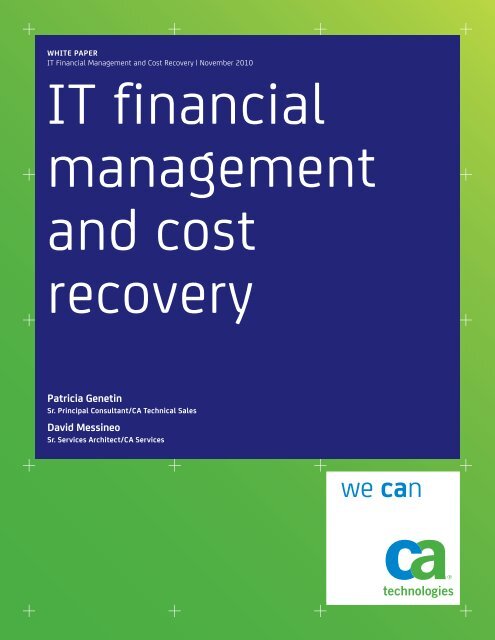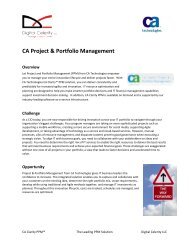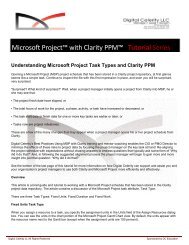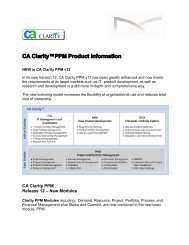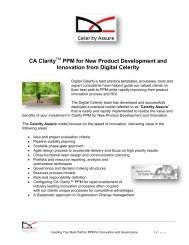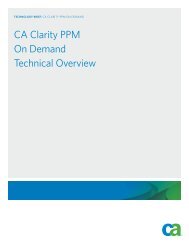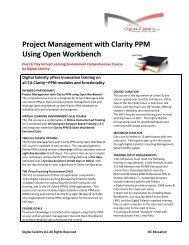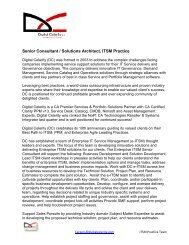IT Financial Management and Cost Recovery - CA Technologies
IT Financial Management and Cost Recovery - CA Technologies
IT Financial Management and Cost Recovery - CA Technologies
Create successful ePaper yourself
Turn your PDF publications into a flip-book with our unique Google optimized e-Paper software.
WH<strong>IT</strong>E PAPER<strong>IT</strong> <strong>Financial</strong> <strong>Management</strong> <strong>and</strong> <strong>Cost</strong> <strong>Recovery</strong> | November 2010<strong>IT</strong> financialmanagement<strong>and</strong> costrecoveryPatricia GenetinSr. Principal Consultant/<strong>CA</strong> Technical SalesDavid MessineoSr. Services Architect/<strong>CA</strong> Serviceswe can
<strong>IT</strong> <strong>Financial</strong> <strong>Management</strong> <strong>and</strong> <strong>Cost</strong> <strong>Recovery</strong>Section 1: ChallengeThe daunting process of implementing an <strong>IT</strong>financial management <strong>and</strong> cost recovery systemThe deceptive “simplicity” of total cost of ownershipSeveral years ago, the Gartner Group introduced the concept of total cost of ownership (TCO) toillustrate how an asset’s contractual costs were not always representative of its true costs. Becausea given asset could be configured in different ways — <strong>and</strong> therefore carry different workloads — thevarying combinations led to the possibility of a wide range of potential costs. Many organizationssupported this analysis <strong>and</strong> implemented procedures attempting to capture an asset’s true cost inorder to derive a clear view of TCO.Calculating return on investment (ROI), a related financial indicator, can be even more cumbersomewhen you consider that predicting returns often includes a large component of estimation. While ROIis a widely accepted st<strong>and</strong>ard <strong>and</strong> can be a very good indicator of the true value of a project, there’s atendency to ignore the costs required for changes beyond immediate implementation.Internal <strong>IT</strong> charges may seem uncontrollableAs infrastructure costs <strong>and</strong> environmental concerns continue to escalate, new policies <strong>and</strong> proceduresare required for analysis <strong>and</strong> control, reuse <strong>and</strong> disposal <strong>and</strong> replacement <strong>and</strong> migration of technology.Meanwhile, executive management no longer assumes that all <strong>IT</strong> investments will result in a financialwindfall <strong>and</strong> often forgo innovation <strong>and</strong> technological advancement opportunities in favor of <strong>IT</strong>’s daily,core activities.Though management may consider <strong>IT</strong> costs to be uncontrollable, <strong>IT</strong> cost recovery is often avoided,as even an utterance of the word “chargeback” elicits thoughts of disputes <strong>and</strong> mistrust. Yet, withoutproperly charging for <strong>IT</strong> resources <strong>and</strong> services, organizations will not receive the critical informationthey need to properly assess options, manage consumption, or underst<strong>and</strong> the business value of <strong>IT</strong>.Therefore, <strong>IT</strong> cost recovery is an imperative <strong>IT</strong>/business dialogue because it encourages conversation<strong>and</strong> provides visibility to the key drivers of cost <strong>and</strong> value.Establishing meanings for cost drivers <strong>and</strong> units of measurePerhaps the most challenging issue <strong>IT</strong> must deal with when developing a cost recovery model is theprocess of identifying <strong>and</strong> establishing appropriate measures. Certainly, measures are necessary. But,what makes a measure appropriate? Consider the SMART acronym that is frequently used when settingobjectives — units of measure should be specific, measurable, relevant, <strong>and</strong> timely.4
<strong>IT</strong> <strong>Financial</strong> <strong>Management</strong> <strong>and</strong> <strong>Cost</strong> <strong>Recovery</strong>Also, consider that some measures have different meanings based on context. Varying interpretationsare driven by timing, roles, responsibilities, comparisons, inferences, perceived alternatives, <strong>and</strong> amyriad of other factors. <strong>IT</strong> must clarify contextual differences by:• Identifying the factors that drive costs• Establishing control over how metrics are identified <strong>and</strong> collected• Defining specific policy <strong>and</strong> rules around the aggregation <strong>and</strong> presentation of metrics• Explaining how measures are calculated <strong>and</strong> whyA primary reason that service level management has become a priority discipline for <strong>IT</strong> is that servicelevel agreements (SLAs) attempt to coordinate <strong>and</strong> confirm communication about what’s requiredfrom <strong>IT</strong>, <strong>and</strong> at what cost <strong>and</strong> quality. It is critical that <strong>IT</strong> underst<strong>and</strong> the needs of the business <strong>and</strong>the influence of the various service levels required to support those needs. Likewise, the businessmust underst<strong>and</strong> <strong>and</strong> rely on what <strong>IT</strong> can provide; measurements must be specifically identified sothey can be monitored to automatically raise alerts when performance or availability degrades towarning levels.Resources are limited<strong>IT</strong> is often instructed to do more with less, while continuing to adequately protect its assets <strong>and</strong>improve service. If resources were unlimited, <strong>IT</strong> could certainly — <strong>and</strong> constantly — provide the highestlevel of service possible. However, funds are limited, making tradeoffs an inherent part of the process.Economists define cost in terms of opportunities that are sacrificed when a choice is made. Conversely,benefits are sometimes quantified as costs avoided. When making tradeoff decisions, it is criticalfor organizations to underst<strong>and</strong> that <strong>IT</strong> exists to support business objectives, <strong>and</strong> as such, optimalinvestment <strong>and</strong> operational decisions dem<strong>and</strong> collaboration between <strong>IT</strong> <strong>and</strong> the business it supports.Is <strong>IT</strong> still a cost center?It has been generally accepted that <strong>IT</strong> operates as a cost center that makes only indirect contributionsto revenue. Even though management relies on <strong>IT</strong> as a strategic asset, the historical focus wasprimarily on back-office efficiency gains. However, <strong>IT</strong> has become a crucial mechanism through whichan organization’s activities with its customers, suppliers, partners, <strong>and</strong> other key resources areperformed — making it a direct contributor to revenue.The discipline of <strong>IT</strong> Service <strong>Management</strong> (<strong>IT</strong>SM) helps transition <strong>IT</strong> from its technology-centric costcenter role to that of an internal, customer-centric service provider focused on managing dem<strong>and</strong><strong>and</strong> encouraging a competitive attitude that drives business goals.The good governance m<strong>and</strong>ateToday, good governance initiatives, such as <strong>IT</strong>SM, are driving <strong>IT</strong> priorities by requiring the tighterresponsibilities, proven controls, <strong>and</strong> enhanced resource stewardship that force organizations toassess <strong>and</strong> improve their processes. These m<strong>and</strong>ates allow <strong>IT</strong> to play an integral role in businesstransformation <strong>and</strong> best practice frameworks by promoting continuous improvement <strong>and</strong> buildingcompetitive advantage. In order to provide the insight required to make the best choices <strong>and</strong> manage<strong>and</strong> control costs, <strong>IT</strong> must develop appropriate cost models with adequate levels of detail. Whencreating these methodologies, <strong>IT</strong> must consider the factors most relevant to sound economicalbehavior.5
<strong>IT</strong> <strong>Financial</strong> <strong>Management</strong> <strong>and</strong> <strong>Cost</strong> <strong>Recovery</strong>Section 2: OpportunityThe winning formula: driving economical behaviorThe good governance m<strong>and</strong>ateProperly charging for services allows organizations to provide adequate information <strong>and</strong> accountabilityfor assessing options, managing consumption <strong>and</strong> determining the true value provided by <strong>IT</strong>. <strong>IT</strong>financial management processes make it possible to simply <strong>and</strong> fairly charge for <strong>IT</strong> services.There are three primary domains where <strong>IT</strong> can look to gain knowledge <strong>and</strong> provide insight whencreating cost-recovery models:• Portfolio management• Vendor management• Resource managementGood <strong>IT</strong> governance requires <strong>IT</strong>/business collaboration across these primary <strong>IT</strong> domains:Figure AA comprehensive <strong>IT</strong>cost recovery platformprovides insight intothe influence serviceportfolios, vendorrelations <strong>and</strong> resourceallocations have on anorganization’s overallcost structure.A comprehensive <strong>IT</strong> cost recovery platform6
<strong>IT</strong> <strong>Financial</strong> <strong>Management</strong> <strong>and</strong> <strong>Cost</strong> <strong>Recovery</strong>Portfolio management provides insight into costsPortfolio management offers a means to validate the rationale for cost recovery methods <strong>and</strong> policies,while supporting stakeholders’ cost/benefit tradeoff decisions. Performing corporate budgetpreparation <strong>and</strong> expense analysis based on costs processed through the general ledger or accountspayable system provides valuable insight into planned expenditures.Service costs, another piece of the portfolio, are computed by recording general ledger <strong>and</strong> budgetamounts as a baseline <strong>and</strong> distributing these costs up the hierarchy to arrive at an accumulated chargeper service. For example, the cost to provide email service actually includes portions of hardware,software, <strong>and</strong> labor costs. Redistributing these amounts to the proper areas helps organizationscompute an aggregated cost of providing email.Consistent measures need to be used to determine the portions allocated to each business unit.Typically, accumulators <strong>and</strong> multiple rounds of allocations are performed to arrive at an aggregatedservice cost. These collected charges represent shared services such as operating system support oradministrative overhead, which once computed, are allocated to the next level in the business servicehierarchy.To improve the reporting <strong>and</strong> analysis of portfolio allocations, cost elements need to be classified as:• operational or capital• direct or indirect• fixed or variableAutomated financial allocation rules <strong>and</strong> features within portfolio management tools simplify thisprocess by helping distribute indirect costs to components or services. Additionally, a unit of measuresuch as counts of user ids, serial numbers, or transactions should be identified for each cost type.Scenarios help <strong>IT</strong> facilitate the planning <strong>and</strong> design of models for distributing shared costs. Insightfrom these discussions can also help identify opportunities for cost optimization <strong>and</strong> influenceoperational initiatives <strong>and</strong> prioritizations.Vendor management provides insight into contractsVendor management tools help <strong>IT</strong> assess procurement processes, improve their underst<strong>and</strong>ing ofexisting third-party agreements, <strong>and</strong> discover opportunities for cost optimization. When vendor costsare fixed, <strong>IT</strong> should encourage usage to optimize the investment. <strong>Cost</strong>s are variable, <strong>IT</strong> should foster anunderst<strong>and</strong>ing that exp<strong>and</strong>ing usage can lead to increased costs. Communication is critical forappropriately influencing business behavior — as are the following questions:• Does <strong>IT</strong> pay for unlimited use software licenses, but then encourage limits through policies thatcharge per use?• Are there prepaid maintenance or warranty agreements that the business does not take advantage ofbecause they do not know they exist?• Are there various rate options available when setting up conference calls or webcasts that couldinfluence user choices if cost factors were known?• How do the costs of printing options differ?7
<strong>IT</strong> <strong>Financial</strong> <strong>Management</strong> <strong>and</strong> <strong>Cost</strong> <strong>Recovery</strong>Only by using a service catalog to quantify cost <strong>and</strong> service level options can organizations underst<strong>and</strong>the financial impact of their choices. Armed with this information, management can implementvendor-related policies <strong>and</strong> procedures to appropriately control <strong>IT</strong> usage.Resource management provides insight into usageResource management ensures assets are identifiable, usage metrics are available <strong>and</strong> cost drivers areunderstood. Tools can help track owned resources <strong>and</strong> automatically discover hardware <strong>and</strong> softwarerelated to those resources within the <strong>IT</strong> environment. Likewise, time-tracking systems provide insightinto labor costs <strong>and</strong> automated reconciliation provides management with an efficient means ofidentifying discrepancies.The fundamental economic concepts of supply <strong>and</strong> dem<strong>and</strong> influence the cost of resources, <strong>and</strong> mustbe considered as well. For example, when dem<strong>and</strong> on <strong>IT</strong> increases, resource spending increases inorder to provide the services needed to meet dem<strong>and</strong>. Many organizations incrementally increaseresource levels beyond dem<strong>and</strong>, meaning they often plan for a capacity that will not be realized.To avoid this situation, it is important to account for the four areas of resource planning:• planned dem<strong>and</strong>• unplanned dem<strong>and</strong>• planned capacity• unplanned capacity<strong>Financial</strong> management methods help <strong>IT</strong> estimate — or plan — dem<strong>and</strong> <strong>and</strong> develop a budget thataccounts for new expenses. To protect against unplanned expenses, an estimate is often added foradditional dem<strong>and</strong> <strong>and</strong> an extra level of capacity is built into budget estimates.Models that define <strong>and</strong> account for customer dem<strong>and</strong>s should be implemented to provide visibilityinto resource costs <strong>and</strong> enable proper management. The business will pay for access to, rather thanactual use of, resources <strong>and</strong> become conscious of identifying real needs, quantifying equirements <strong>and</strong>prioritizing by value. For example, instead of requesting disk space consumers will pay for the ability toaccess <strong>and</strong> store email for a specific number of users, or instead of buying b<strong>and</strong>width consumers willrequest system access with a quantifiable response time.Dem<strong>and</strong>-focused charging or cost recovery models such as these shift the business conversationto a discussion of value <strong>and</strong> facilitates a consensus about how <strong>IT</strong> resources should be contributed.Responsibility for managing capacity, <strong>and</strong> its cost, is left appropriately with <strong>IT</strong> specialists.Building the cost recovery systemUnderst<strong>and</strong>ing the distributions of costs <strong>and</strong> assets across the areas of portfolio, vendor, <strong>and</strong>resource management provides organizations with the information needed to achieve financialoptimization. Pairing this awareness with cost recovery processes grants <strong>IT</strong> the ability to improvefinancial management <strong>and</strong> steer stakeholders toward cost-effective decisions. <strong>IT</strong> cost recovery shouldbe used as a key technique to encourage <strong>and</strong> provide an incentive for the efficient, effective <strong>and</strong>economical use of technology resources.8
<strong>IT</strong> <strong>Financial</strong> <strong>Management</strong> <strong>and</strong> <strong>Cost</strong> <strong>Recovery</strong>A comprehensive cost recovery platform enables governance <strong>and</strong> accountability, <strong>and</strong> provides a choiceof options for insight into costs, contracts, <strong>and</strong> usage, allowing <strong>IT</strong> to gain an underst<strong>and</strong>ing of thefactors needed to drive economical preferences.Organizations should follow these practical steps for implementing a cost recovery <strong>and</strong> chargebackmethodology:1. Define <strong>and</strong> catalog <strong>IT</strong> services, including business-oriented descriptions, scope, service levels,measurements, owners, customers, <strong>and</strong> users2. Determine the components that make up services, including people, hardware, operating systems<strong>and</strong> application software3. Identify the cost elements related to each servicea. Review accounts payable listings to determine which costs may be assigned directly toservices, <strong>and</strong> which are overhead or indirect costsb. Categorize direct <strong>and</strong> indirect costs by specific ownership accountabilityc. Review contracts <strong>and</strong> identify important terms <strong>and</strong> conditionsd. Categorize costs as fixed or variable4. Determine how low-level services relate to higher-level offeringsa. Analyze usage patternsb. Identify metrics as cost drivers5. Develop a chargeback strategy for each service offering <strong>and</strong> formulate a model that best driveseconomical behavior6. Review operating <strong>and</strong> financial principles with corporate functions such as controlling, budgeting,procurement, tax <strong>and</strong> general accountinga. Determine how account coding structures assist in the automation of cost distributionsb. Consider st<strong>and</strong>ards <strong>and</strong> naming conventions for use in verifying appropriate identificationof cost attributes such as fixed, variable, direct <strong>and</strong> indirect7. Build awareness around adopting chargeback methodologya. Build business relationships <strong>and</strong> share <strong>IT</strong>/business objectives <strong>and</strong> strategiesb. Educate <strong>and</strong> communicatec. Focus on policies <strong>and</strong> exception management8. Gather appropriate approvals <strong>and</strong> ensure buy-in9. Implement chargeback methodology, including baseline reporting <strong>and</strong> key performanceindicators (KPIs)10. Measure <strong>and</strong> report on savings realized, then solicit feedback <strong>and</strong> provide continuous reviewfor ongoing process9
<strong>IT</strong> <strong>Financial</strong> <strong>Management</strong> <strong>and</strong> <strong>Cost</strong> <strong>Recovery</strong>Section 4: ConclusionsOrganizations looking to establish <strong>IT</strong> cost recovery processes do so in order to underst<strong>and</strong> the truecost of a service or asset. However, many struggle to achieve this goal because of tight budgetaryconstraints <strong>and</strong> a lack of insight into the steps that need to be taken along the way. Gaining insightinto the distributions of costs across portfolios, vendors <strong>and</strong> resources opens the door to developingclear, comprehensive <strong>IT</strong> cost recovery processes. Using this knowledge to build concrete <strong>IT</strong> financialmanagement <strong>and</strong> cost recovery processes allows <strong>IT</strong> <strong>and</strong> the organization it supports to better aligneconomic planning <strong>and</strong> budgetary decisions with business goals <strong>and</strong> simplify cost allocations, improvevisibility into cost structure <strong>and</strong> optimize resource management.Section 5: About the authorsPatricia Genetin is a Certified Public Accountant (CPA) <strong>and</strong> Senior Principal Consultant in the TechnicalSales organization at <strong>CA</strong> <strong>Technologies</strong>. She is an expert <strong>and</strong> a leader with experience over 20 yearsspanning software development, business operations, management, <strong>and</strong> corporate governance. Sheachieved the highest <strong>IT</strong> Infrastructure Library (<strong>IT</strong>IL) v2 certification, <strong>IT</strong>IL Service Manager, <strong>and</strong> currentlyuses this knowledge, along with her deep technology <strong>and</strong> financial expertise, to advise organizationson measuring the value of their <strong>IT</strong> portfolios <strong>and</strong> potential investments.David Messineo is an <strong>IT</strong>SM Practitioner with more than 20 years experience developing <strong>and</strong> deployingenterprise-level software solutions focused on <strong>IT</strong> management. He is currently a Senior Architect<strong>and</strong> Researcher at <strong>CA</strong> <strong>Technologies</strong> where he is responsible for implementing a holistic performancemeasurement framework across <strong>CA</strong>’s solution portfolio. David holds both an <strong>IT</strong>IL Service Manager <strong>and</strong>eSCM Certification.To learn more about the <strong>CA</strong> Service <strong>Management</strong> solutions, visit ca.com/itsm. For more informationon <strong>CA</strong> <strong>and</strong> <strong>IT</strong>IL, visit ca.com/itil. And to discover how you can define <strong>and</strong> publish services <strong>and</strong> providefinancial insight into service consumption, take a look at ca.com/servicecatalog.11
<strong>CA</strong> <strong>Technologies</strong> is an <strong>IT</strong> management software <strong>and</strong> solutions company withexpertise across all <strong>IT</strong> environments—from mainframe <strong>and</strong> distributed, tovirtual <strong>and</strong> cloud. <strong>CA</strong> <strong>Technologies</strong> manages <strong>and</strong> secures <strong>IT</strong> environments<strong>and</strong> enables customers to deliver more flexible <strong>IT</strong> services. <strong>CA</strong> <strong>Technologies</strong>innovative products <strong>and</strong> services provide the insight <strong>and</strong> control essentialfor <strong>IT</strong> organizations to power business agility. The majority of the GlobalFortune 500 rely on <strong>CA</strong> <strong>Technologies</strong> to manage their evolving <strong>IT</strong> ecosystems.For additional information, visit <strong>CA</strong> <strong>Technologies</strong> at ca.com.Copyright ©2010 <strong>CA</strong>. All rights reserved. All trademarks, trade names, service marks <strong>and</strong> logos referenced herein belong to theirrespective companies. This document is for your informational purposes only. <strong>CA</strong> assumes no responsibility for the accuracy orcompleteness of the information. To the extent permitted by applicable law, <strong>CA</strong> provides this document “as is” without warrantyof any kind, including, without limitation, any implied warranties of merchantability, fitness for a particular purpose, or noninfringement.In no event will <strong>CA</strong> be liable for any loss or damage, direct or indirect, from the use of this document, including,without limitation, lost profits, business interruption, goodwill, or lost data, even if <strong>CA</strong> is expressly advised in advance of thepossibility of such damages.CS0199_1110


